Home |
What's New |
Features |
Gallery |
Reviews |
Reference |
Forum |
Search
|
|
Dornier Do335A-1"Pfeil" (Arrow)History and
ZG 26 Model by Mark Tucker
|
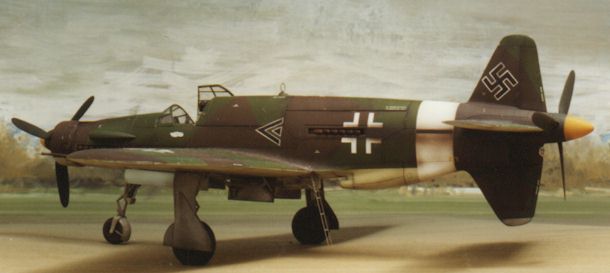 |
Dragon/DML's
1/72 Scale Dornier Do 335A-1 |
Contents
Background
Wartime
Photos
Do 335 Specifications
DML's
Do 335 in 1/72 Scale
Additional Model Photos by
Peter Fritz
The Dornier 335 Arrow was one of the most unusual fighters of the Second World War.
Equipped with two Daimler-Benz V-12 engines, the most powerful available at the time, it was probably the fastest propeller driven aircraft of the period. With one engine mounted conventionally in the nose driving a propeller at the front of the aircraft and one engine buried mid-fuselage driving a rear mounted propeller, it had the aerodynamic characteristics of a single-engined fighter yet the power of a twin.
The prototype Do335 V1, W.Nr 230001, CP+UA, made its maiden flight from Dornier's Friedrichhafen plant on 26 October 1943. On the fourth flight the Do335 V1 attained a speed of 600km/h (373mph) at sea level, it was found that the aircraft could fly faster with the forward engine stopped, than with the rear propeller feathered. A speed of 560km/h (348mph) was possible in the former condition.
The Do335 appeared on the production line too late to see operational service. Less than 70 Do335's of all types were completed.
The following images were provided by Charlie Swank. Do 335s taken at Oberpfaffenhofen, Germany on May 12 1945.
|
Do335A-O W.Nr 240105 pretty well shot up as target pratice. Note: This aircraft has no radio codes - only the aircraft werknummer abbreviation. Note the outline style Hakenkreutz and very low contrast upper-surface camouflage colours. The colours are quite possibly RLM 81 Brown-Violet and RLM 83 Dark Green, but some earlier, obsolete colours (including RLM 70 and 71) were often used on these aircraft. |
|
Four Do 335s. Single seaters and two seat trainers can be seen in this post-war scrapyard. Werknummern present are Do335A-12 (240012); #114 (240114); Do335A-O #103 (240103) and Do335A-12 #119 (240119). Note: 240119 is unpainted except for the rudder and tail planes which appear to be painted in RLM 70 Black-Green. The only markings on this aircraft are the Hakenkreuz and serial number. The wreckage of an Me 262 is in the foreground. |
Powerplant:
Two Daimler-Benz DB603A-2 12-cylinder inverted-vee liquid cooled engines in push-pull
arrangement each rated at 1,750 hp for take-off.
Armament:
One 30 mm MK103 cannon with 70 rounds, firing through the front propeller hub, and two 15
mm MG151/15 cannon with 200 r.p.g. above the nose, plus one 500 kg bomb or two 250 kg
bombs internally and 250 kg bombs on underwing racks.
Performance:
Max speed at sea level 580 km/h (360mph). Max speed at 21,000 ft (6,400 m) 763 km/h (477
mph). Econonmical cruising speed 472 km/h (293 mph) at 6,000 m (19,685 ft). Range on
internal fuel at max continuous power 1400 km (867 miles), at economical cruise power 2050
km (1,280 miles); Time to 1000 m (3,280 ft) 55 sec, to 8000 m (26,245 ft) 14.5 min;
Service ceiling 9,500 m (31,168 ft).
Weights:
Empty equipped 7,260 kg (16,005 lb); Normal loaded 9,600 kg (21,165 lb).
Dimensions:
Span 13.8 m (45 ft 3¼ in); Length 13.85 m (45 ft 4¼ in); Height 5.0 m (16 ft 4 ¾ in):
Wing area 38.5 sq m (414.411 sq ft).
The only surviving example of the Do335 is currently in storage at the Paul Garber facility of the Smithsonian Institute NASM in the USA. The aircraft, due to its size, has been disassembled for ease of storage due to the limited space available at the facility.
Pictures of this aircraft can be seen below:
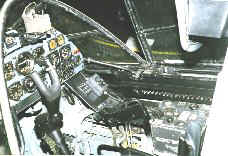 |
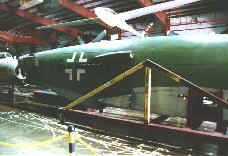 |
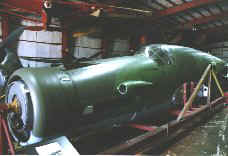 |
The Kit
The kit is the DML/Dragon Do335A-1. This is one of four Do335 series aircraft models produced by the Hong Kong based company. The other three variants are the Do335A-12 two-seat Trainer, the Do335B-6 radar equiped two-seat Night Fighter and the Do335B-2 Zerstorer (destroyer) Heavy Fighter, armed with three 30mm cannons and two 15mm machine guns.
 The box contains seven nicely moulded sprues in light grey
plastic, one sprue of clear parts and a fret of etched stainless steel? parts. The
fuselage and wings feature fine recessed panel lines with options to display both the
forward and rear engine compartments open. The kit DB603 engines are models in themselves
each containing over 20 parts!. The aircrafts unique folding metal boarding ladder is an
etched steel item and can be displayed in the open position.
The box contains seven nicely moulded sprues in light grey
plastic, one sprue of clear parts and a fret of etched stainless steel? parts. The
fuselage and wings feature fine recessed panel lines with options to display both the
forward and rear engine compartments open. The kit DB603 engines are models in themselves
each containing over 20 parts!. The aircrafts unique folding metal boarding ladder is an
etched steel item and can be displayed in the open position.
Instructions
The instructions are typical DML/Dragon foldout type with sub-assembly
drawing and twelve stages of construction, decal placement and a RLM colour painting guide
which list Gunze Sangyo paint numbers. A parts breakdown is also included.
Construction
As this aircraft is fitted with a tricycle undercarriage, a fair amount of weight will be required to be placed in the nose to ensure that the model sits on all three wheels. Herein lie the problems.
1) I found that if you mount the front engine in the fuselage there is insufficient room to put any ballast. The kit instructions tell you to place ballast behind the engine firewall and in the wing leading edges. This I did and still ended up with a tail sitter! Therefore I suggest not mounting the front engine and place the ballast inside the engine compartment.
2) If you omit the front engine you are left with no locating pin for the alignment of the front radiator and cowling and no where to mount the exhausts!
To overcome this I added a strip of sheet styrene to the inside of the fuselage walls covering the openings for the exhausts. I then glued the kit exhausts to this strip from outside the fuselage. I found out that the radiator cowling can be fitted to the front of the fuselage with out the locating pin, with a little fiddling. Just be sure that the wider part of the radiator intake mouth is at the bottom when you glue it to the fuselage.
The rest of the kit parts fitted fairley well with the rear fuselage sub-section joins following panelines. The wing leading edges have inserts that need to be glued in place. These inserts on the Do335B-2 kit contain the 30mm cannon bulges and ejector chutes. I suggest you do not glue the upper and lower halves of these inserts together or glue them to the wing until you have joined the upper and lower halves of the wing. The inserts were , on my kit, thicker in chord than the wing and required a fair amount of filler. I recommend that you do a lot of dry fitting before you glue the pieces together as this will save you having to fill and rescribe the wings later. Those of you that have built the 1/48 Fw190D-9 kit will be familiar with the wing root problems that seem to befall all DML kits. This kit is no exception, so you will need to place a "spreader bar" inside the fuselage to close the wing root fillet gaps. Once I had the "spreader bar" installed the wing root only needed a little filler at the front.
The cockpit detail is pretty good with raised details on the instrument panel. Unfortunately my trained "cockpit painting" spider decided to go on strike, something about extra flies for working on a public holiday!, so I had to paint the dials and instrument panel by hand. Don't you just hate those trade unionists! Either I am getting old or 1/72 scale models are getting smaller! Fortunately Eduard make a photo etched set for this aircraft and it provides a photo acetate sheet with the instruments on it. Much easier than painting!
Painting and Decals
The kit has markings for two pre-production aircraft Do335A-O2 VG + PG W.Nr 240102, this is the aircraft currently stored in the USA, and Do335A-O7 W.Nr 240107. The later having no radio codes as only the first two pre-production aircraft had their primary indentification codes painted on the fuselage. The remaining eight pre-production aircraft having them deleted. No Hakenkreuz (swastikas) are provided.
The kit instructions indicate the upper wing and fuselage colours as being Gunze H304 Olive drab and Gunze H309 Dark Green.
Most of the pre-production Do335's completed by Dornier were painted RLM 70/71/65 except for the Do 335 V1, which was painted in overall RLM 71 with RLM 65 undersurfaces and the propellers and spinners painted in RLM 70.The standard scheme for twin-engined bombers and reconnaissance aircraft was RLM 70/71/65.
In July 1944 RLM issued a directive that the colours 70, 71 & 65 were to be replaced with new colours 81,82 & 76. It would appear that even after the directive of July 1944 Dornier continued painting aircraft in the 70/71/65 scheme.
Whether this was because they had adequate stocks of these colours and wished to use them up before adopting the 81/82/76 scheme is not known. When Dornier restored Do335A-O 2 in 1975 they repainted the aircraft in a scheme of 81/82/76. This was not the aircraft's original scheme, but it was the official scheme specified.
As I wanted to depict a "what if" operational type aircraft, I chose a spurious scheme of late war colours RLM 81 Brown-Violet, RLM 82 Bright Green and RLM 84 Green-Grey, with some panels painted to represent natural metal on the lower surfaces. This expedient finish was typical of many late war fighters and bombers.
The markings are purely speculative and are of a ZG (Zerstorergeschwader) 26 Gruppe Kommandeur!
Peter Fritz has also contributed images of his single seater and two-seater Do 335 in
1/72 scale. The single seater represents an aircraft attached to the reconnaissance unit of "Oberbefehlshaber der Luftwaffe" (Chief of the
Air Force). The two-seater is a prototype of the later planned night-fighter.
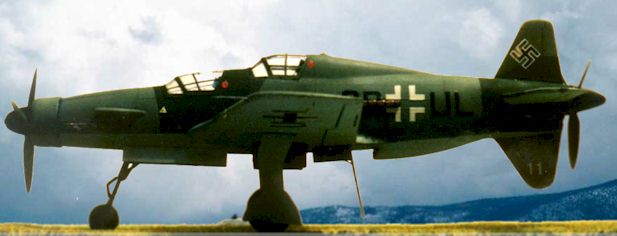
Click on the Thumbnails below to view the images full-size. Click on the Back Arrow on your browser to return to this page
ZG 26 Model and Text Copryright 1998 by Mark Tucker
Photographs of Mark's Do 335 Model Copyright 1998 by Pieter Stroethoff
Wartime Do 335 Images Copyright 1998 by Charlie Swank
Additional Model Photo Copyright 1998 by Peter
Fritz
Paul Garber Facility photographs via Gary Hethcoat's Web Site
Page Originally Created March 1998
Last updated 18 May 2001
Back to HyperScale Main Page
Back to the Reference Library